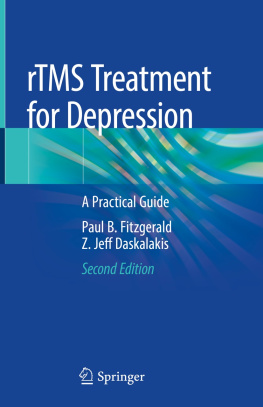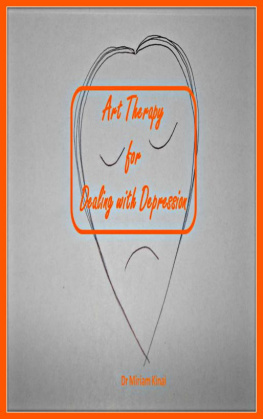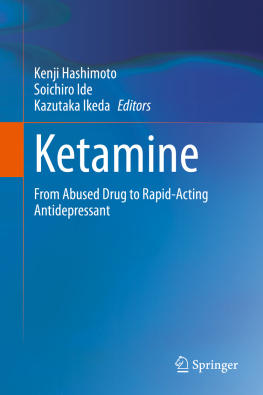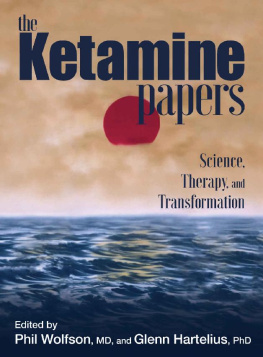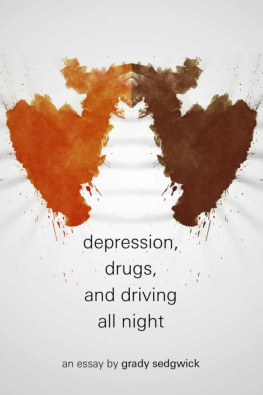Ketamine for Depression
Dr. Stephen J. Hyde
Copyright 2015 by Dr. Stephen J. Hyde.
Library of Congress Control Number: 2015913931
ISBN: Hardcover 978-1-5035-0955-9
Softcover 978-1-5035-0954-2
eBook 978-1-5035-0953-5
All rights reserved. No part of this book may be reproduced or transmitted in any form or by any means, electronic or mechanical, including photocopying, recording, or by any information storage and retrieval system, without permission in writing from the copyright owner.
Any people depicted in stock imagery provided by Thinkstock are models, and such images are being used for illustrative purposes only.
Certain stock imagery Thinkstock.
Cover image:
Ketamine dropped on Photonegative, enlarged
Sarah Ancelle Schoenfeld
Rev. date: 12/03/2018
Xlibris
1-800-455-039
www.Xlibris.com.au
719781
Contents
Dedication
For my patients and for all who battle with depression and those who support them.
To the Xlibris family Carl, Ann, Marie, Mark and Stephanie for their expert advice and assistance.
To the ketamine doctors, Angelo, Varun, Graham and Diogo who have been so generous with their time and knowledge.
And thanks to my family for all their support, to my peer group for their patience, to Shelagh for her tolerance and for turning my bullet points into something readable, to the trail-blazing researchers and practitioners of ketamine and most of all to my patients whose stubbornness and courage have encouraged me to continue to look for better treatments.
Truth is indeed stranger than fiction! Many years ago when I was a clinical pharmacologist-working part time at the Lafayette Clinic, I ran the drug abuse-screening laboratory. I was often referred drug abuse patients by the attending psychiatrists. Several referrals dealt with phencyclidine and ketamine drug abuse, especially in the late 70s and early 80s. A number of these patients were mentally depressed, taking various antidepressants off and on. I remember one young lady, in particular, who was a chronic phencyclidine and later ketamine abuser. She had serious bouts of mental depression. I asked her why she took these illicit drugs rather than her usual antidepressant medications. Her answer was Oh, doctor, my antidepressants dont work as well. She stated that ketamine and phencyclidine worked quickly and were much better antidepressants but they didnt last as long so she took them again and again. I promptly recommended that she stop this bizarre practice because it would only harm her. I never pursued the possible antidepressant actions of ketamine. After all - I knew better!
. When Zarate et al. in 2006 reported their positive results with ketamine in a randomised trial of treatment-resistant major depression, I became a believer. I thought of my Lafayette Clinic referral patient of years ago. Again I learned an important lesson. Doctor, listen to your patients and what they tell you!
Edward F Domino MD who, in 1964, was the first doctor to administer Ketamine to a human.
(Taming the Ketamine Tiger.
Anesthesiology, V 113 No 3 September 2010)
Chapter 1
My Journey with Ketamine
I work as a psychiatrist in private practice, seeing people who are not quite ill enough to need to be in hospital but not quite well enough to be managed solely in general practice. Although I am now semi-retired, I still see nearly 90 long-term patients who have made it quite clear to me that I need to stay around until they are cured.
This is proving to be difficult.
I had been vaguely aware of ketamine from sporadic reports of its use over the past 18 years, but what really attracted my attention was what happened 6 years ago when one of my patients was given a 10-day subcutaneous (under the skin) ketamine infusion for severe persistent pain. This treatment worked well for her pain, but it also noticeably improved the severe depressive symptoms she was experiencing at that time. Was it a coincidence? Perhaps not having the pain had made the difference. My interest subsided.
In early 2014, I was trying to help a man with chronic, severe obsessive-compulsive disorder (OCD) who needed six hours to complete his bathroom rituals, and we were discussing the possibility of brain surgery. One must bear in mind that brain surgery is reserved for the most intractable of cases; all possible treatments have to have been tried and failed before surgery is contemplated.
I then read that intravenous ketamine had been helpful in reducing OCD symptoms in a small group of patients treated in America. I discussed this with my patient, and as he was keen to try anything that could help, I sought permission from our local private hospital to test this treatment. The process of obtaining and submitting the required information to be reviewed by the Medical Advisory Committee was time consuming, and there was then a period of two months to wait before the next meeting of the committee. During this time, I explored all the research I could find on ketamine, downloading over 500 studies and articles from the fields of anaesthetics, pain medicine, and psychiatry.
Deep into this process and deeper still into Google I found two articles which led me to change my way of thinking dramatically.
The first was by a group of Brazilian psychiatrists, Diogo Lara and colleagues, who reported success in helping people with treatment-resistant mood disorders using very-low-dose sublingual (placed under the tongue) ketamine. This approach was in stark contrast to the vast majority of published trials to date, which have used the intravenous route, requiring hospitals, anaesthetists, intensive monitoring, and not the least, considerable expense.
This led me to consider the next big question: how safe is it to take ketamine for extended periods? Most of the early trials had involved either the use of single doses or, at most, treatment for two weeks. However, the second article I discovered described the quite remarkable work of Varun Jaitly, an anaesthetist and pain medicine specialist working in the United Kingdom. He had been using sublingual ketamine over the past 15 years to treat a variety of chronic pain conditions not responding to the usual remedies. He reported that ketamine was helpful in around 20% of these very-tough-to-treat conditions, but more importantly, he had monitored patients over the years and had not observed major problems with long-term use (one patient has been taking it 3 times a day for 15 years). In particular, there had been no signs of dependence or addiction nor any indications of bladder problems that can affect those who abuse ketamine by taking very high doses regularly for non-medical reasons.
Encouraged by these reports and by other small-scale studies, I found describing the use of oral ketamine I developed a treatment protocol, and after discussions with my peer review group, I began treating some of my most difficult patients with the low-dose sublingual method in November 2014 (see the appendices for the treatment process, consent form, sample scripts, and patient information sheets).
The most notable features of my treatment are:
After a trial dose of ketamine monitored in my consulting rooms, patients self-administer further doses at home, taking it every second day initially. They continue with their current treatments.
If there is no improvement, the dose is gradually increased until either clear benefit has been obtained or side effects become troublesome.
Those who improve fully then extend the interval between their doses by only taking another when there are signs that their mood is slipping. At this point, trials of reducing other medications can begin.
For those who partially improve, we continue to test combinations of talking therapies, medications, dietary change, and exercise along with ketamine to try to get the best response. Ketamine may be stopped for a trial period to clarify its benefits.
Next page


